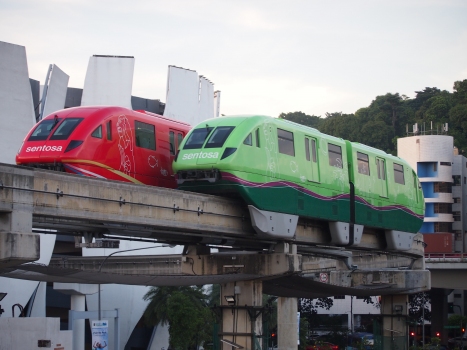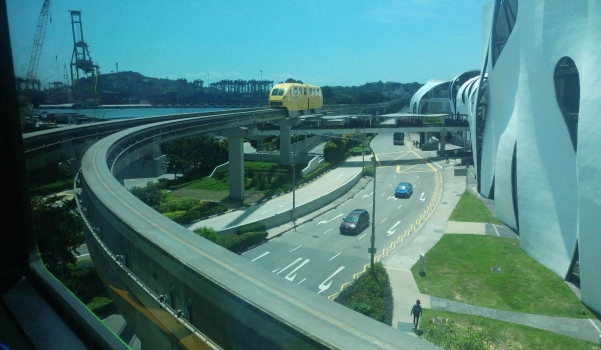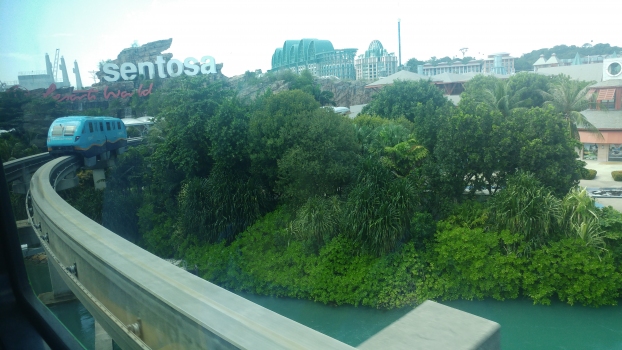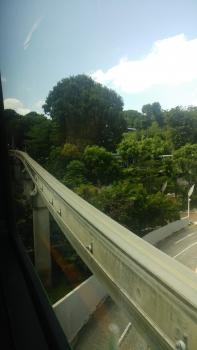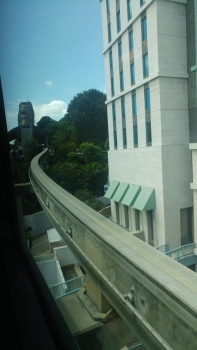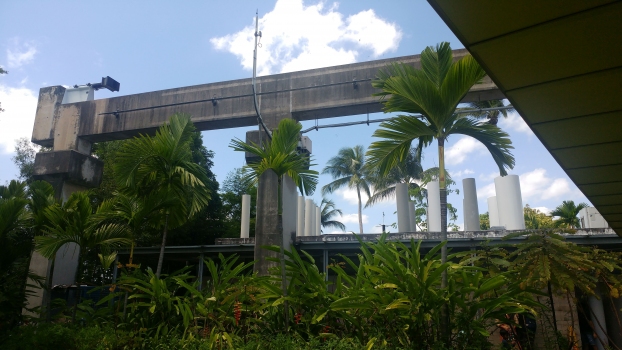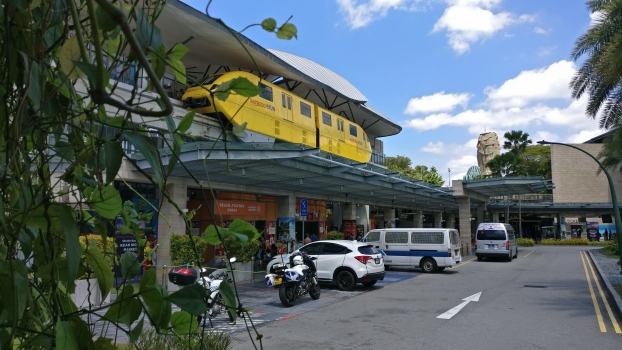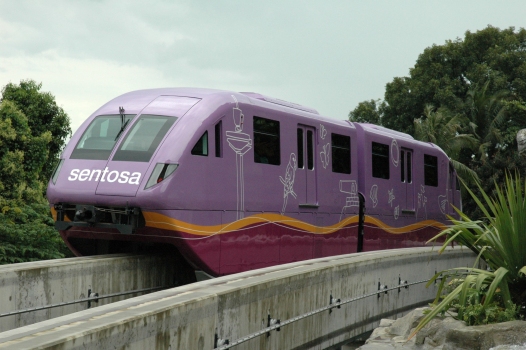General Information
Project Type
| Function / usage: |
Monorail line |
|---|
Location
| km | Name |
Technical Information
Dimensions
| total length | 2.1 km | |
| number of tracks | 2 | |
| number of stations | 4 |
Excerpt from Wikipedia
The Sentosa Express is a monorail line connecting Sentosa island to HarbourFront on the Singapore mainland across the waters.
Built at a cost of S$140 million, development started in June 2003 and was completed in December 2006. The fully elevated 2.1-kilometre (1.3-mile; per direction) two-way line (4.3-km total track length) and three out of four stations opened on 15 January 2007. The fourth station, Resorts World (formerly Waterfront), opened on 1 February 2010.
The monorail system, privately owned and operated by Sentosa Development Corporation, can move up to 4,000 passengers per hour per direction.
Train timings
The daily first and last train timings of both VivoCity and Beach stations are 07:00 and 00:00 hours. Trains run at an average frequency of three minutes throughout the day. The entire route, from one terminus to the other, takes eight minutes.
Fares and ticketing
Travel within Sentosa (between Resorts World and Beach stations) and back to the mainland is free of charge, but travel from the mainland to Sentosa is charged.
The single-day Sentosa Pass costing S$4 allows island entry and unlimited rides on the Sentosa Express. The contactless RFID card can be purchased from automated ticketing machines at any operational Sentosa Express station. Payment can be made using cash, NETS or credit card.
Alternatively, visitors may also scan their CEPAS cards (used for electronic payments on public transport) on VivoCity station's faregates for entry payment from the mainland.
Stations
S$26 million was spent on the elevated stations and the depot next to Beach station. VivoCity station is the only station of the line on the mainland; the rest are on Sentosa. It is also the only one with full-height platform screen doors and a bay platform using the Spanish solution. The other stations on Sentosa island are not air-conditioned and are the first train stations in the country to utilise half height platform screen doors.
Like the Mass Rapid Transit, stations have bi-directional escalators and a lift to take passengers from the station concourse to the platforms, except VivoCity station which has both on the same level within VivoCity on the mainland.
VivoCity
The northern terminus VivoCity station (previously Sentosa @ VivoCity) is just a few levels above HarbourFront MRT station and the nearby HarbourFront Bus Interchange, located within the mall it is named after. Like Changi Airport and Stevens MRT stations, ticketing, faregates and platforms are all on the same level.
The station consists of a single track and a single platform handling Beach-bound trains for turnaround. Like the dismantled Sentosa Monorail stations in the past, it is one of two train stations in Singapore, the other being Choa Chu Kang LRT station, to feature an organised boarding system like the Spanish solution - passengers enter via one side of the train after passengers have alighted on the other side. Doors will open on the left side for passengers to alight, before opening the doors on the right for boarding passengers. This is the only station on the Sentosa Express that is air-conditioned and utilises full-height platform screen doors.
On 1 April 2019, the station was renamed to its present name to better reflect the nearby attractions.
Resorts World
Resorts World station is located in the northern region of Sentosa within Resorts World Sentosa. Platform A handles Beach-bound trains, while Platform B handles VivoCity-bound trains. There are two tracks and one island platform. As the line is left-hand drive, all train doors open on the right. It also connects to the Resorts World Sentosa.
The original station did not open for service before being demolished in December 2007, less than a year after the monorail line's opening, to make way for the construction of Resorts World Sentosa. The station was rebuilt and opened on 1 February 2010 under the name Waterfront station. On 1 April 2019, the station was renamed to its present name to better reflect the nearby attractions.
Imbiah
Imbiah station is located in the middle of Sentosa next to Imbiah Lookout. Platform A handles Beach-bound trains, while Platform B handles VivoCity-bound trains. There are two tracks and one island platform. As the line is left-hand drive, all train doors open on the right. The nearest attraction is Madame Tussauds Singapore.
Beach
The southern terminus Beach station is located between Siloso Beach and Palawan Beach at Sentosa. The station consists of a single track and a single Platform A handling VivoCity-bound trains for turnaround.
At the street level, there are beaches, shops, sea sports, pubs, cafés, and restaurants. It is connected to the Beach Station Bus Terminal for transfers to trams, SBS Transit Bus Service 123, as well as Sentosa Internal Bus Services A and B. The blue trams go to Siloso Beach while the green ones to get to Palawan and Tanjong Beaches.
Rolling stock
Main article: Hitachi small-type monorail (Sentosa Express)
The Sentosa Express is the first system to use Hitachi's small and straddle–type monorail with a capacity of about 184 passengers per train. With a total of seven two-car, 25-metre-long trains of different colours each—namely green, orange, blue, purple, pink, red and yellow; the pink and red trains were added to the original fleet of four on 1 December 2009; the yellow train was added on 24 November 2017. In 2015, the orange train was painted into a multi-coloured livery train. In addition, there are 2 other yellow maintenance trains.
Daily, five monorails are picked to be deployed on the line while the other two remain in the depot.
Signalling
A switch over from Fixed-block Hitachi Digital ATP and ATS to Hitachi's Moving-block Wireless CBTC was conducted in November 2017. The new CBTC system uses wireless communication to gather data on trains' locations and speeds so that the headway between trains can be reduced. This will reduce the travel times for passengers, and allowing more trains to run together for greater capacity. With the implementation of the driverless CBTC system, all train cab windows are opened except during manual operation. Train Captains are still present in the front train cab to manage and monitor the security on the train.
Incidents
On 4 December 2014, a technical fault caused power disruptions on the monorail and stalled a train during the night; several passengers were evacuated.
Text imported from Wikipedia article "Sentosa Express" and modified on April 20, 2020 according to the CC-BY-SA 4.0 International license.
Participants
Currently there is no information available about persons or companies having participated in this project.
Relevant Web Sites
- About this
data sheet - Structure-ID
20079265 - Published on:
19/04/2020 - Last updated on:
28/05/2021

